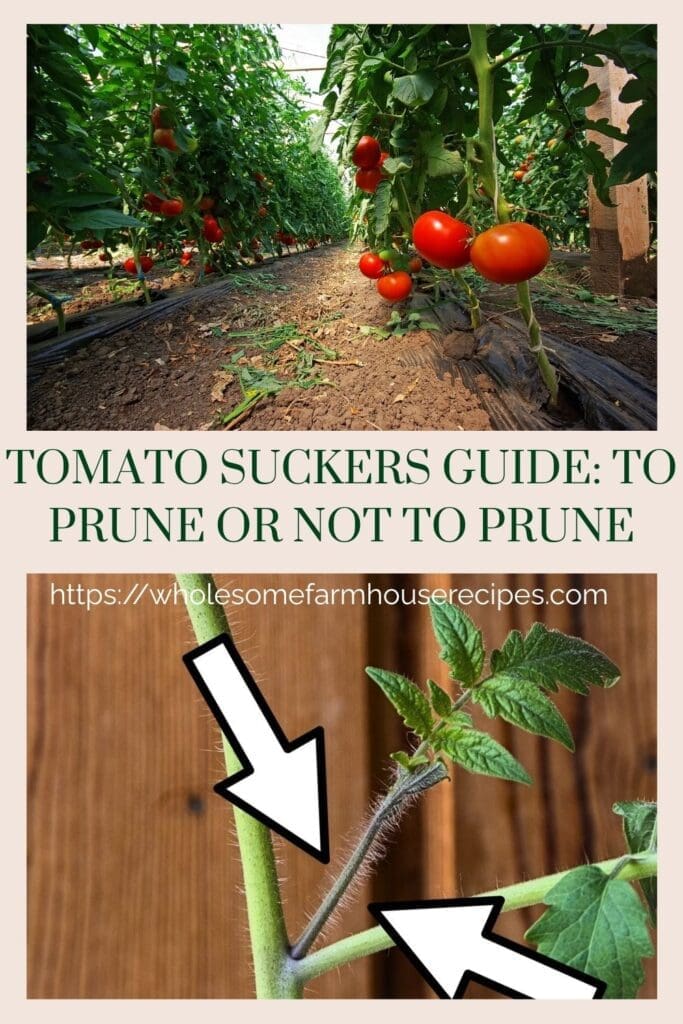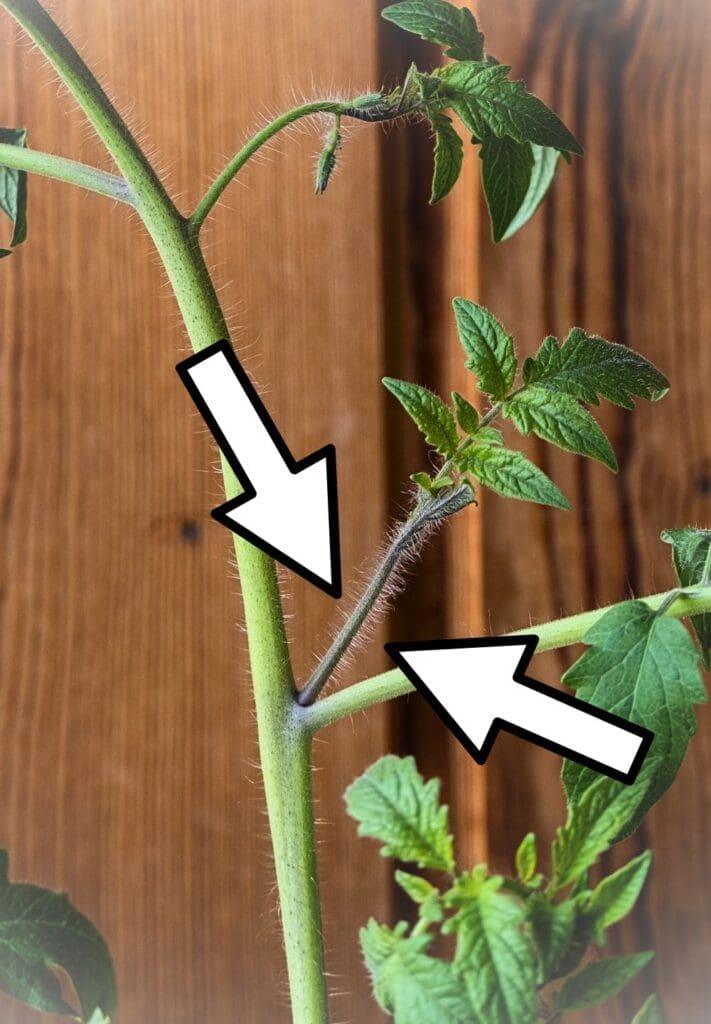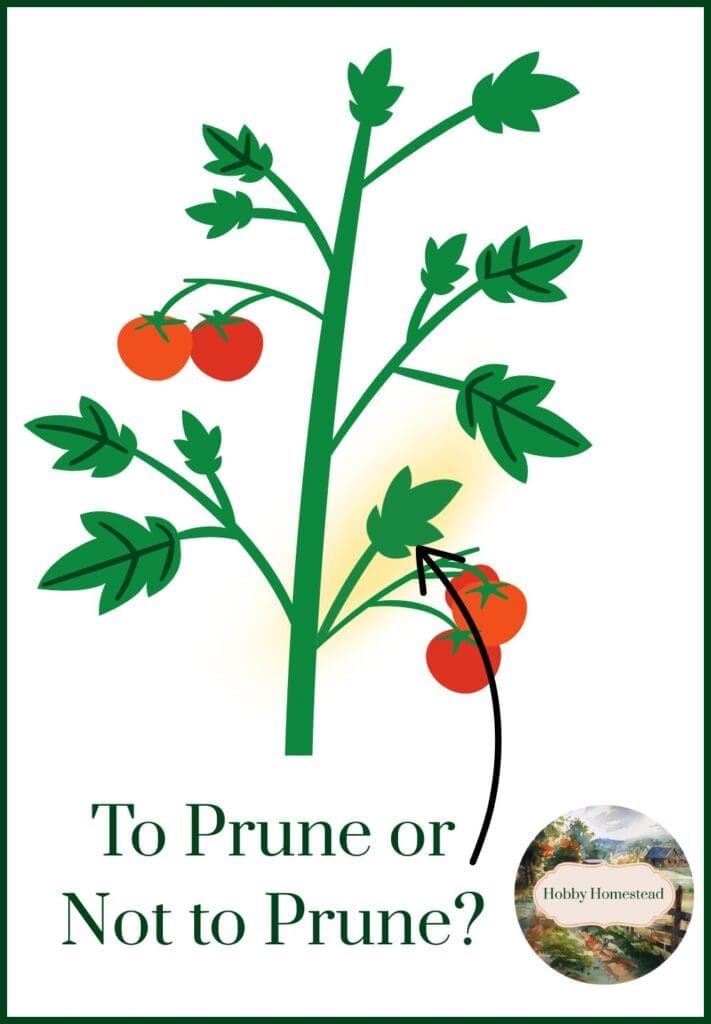Last updated on July 25th, 2025 at 01:11 pm
Should you prune tomato suckers? If you’ve ever grown tomato plants and noticed small shoots sprouting between the main stem and branches, you’ve already met a tomato sucker.
But what exactly are they? Should you remove them? Or leave them alone? In this guide, we’ll walk through everything you need to know about tomato suckers so you can make an informed decision based on your garden goals.
What Are Tomato Suckers?
Tomato plant suckers are small shoots or stems that grow from the leaf axil, the spot where a branch meets the main stem. Suckers are also known as secondary stems.
These offshoots will eventually grow into full-sized branches, producing leaves, flowers, and potentially fruit. All tomato plants naturally produce suckers. It’s part of how they grow.

Pros and Cons of Removing Suckers
Pros of Removing Suckers
- Encourages earlier, larger fruits. With fewer branches competing for a lot of energy, the plant can focus on ripening existing fruit faster and creating bigger tomatoes.
- Better air circulation. Improved air flow by pruning opens up the plant’s interior, reducing the risk of fungal disease.
- Simplifies staking and support. A pruned plant is easier to manage and support with stakes, cages, or trellises.
- More controlled growth. Pruning helps direct the plant’s energy, especially important in smaller garden spaces.
Cons of Removing Suckers
- Less fruit production. Though each fruit may be larger, the plant may produce fewer tomatoes.
- More work. Pruning requires time and consistent monitoring.
- Reduces natural growth. Some gardeners prefer a bushier, fuller look and the potential for more flowering branches.
Types of Tomatoes: Indeterminate vs. Determinate Varieties
Before deciding to prune suckers, it’s helpful to know the type of tomato you have. Varieties of tomatoes can be indeterminate or determinate.
- Indeterminate tomato plants grow continuously and can reach great heights. They benefit the most from sucker removal to encourage larger fruit and better airflow.
- Determinate tomatoes grow to a set height and produce fruit in a short window. Pruning suckers on these can reduce the number of tomatoes, so it’s usually best to leave them alone.
When to Do the First Pruning
The first pruning should be done when your tomato seedlings are about 12–18 inches tall and have at least 5–7 sets of true leaves.
At this stage, the plant is established enough to handle pruning without stress, and small suckers will just be starting to appear.
This is the ideal time to remove them while they are still small and easy to pinch off by hand. This prevents large open wounds on the plant.

We have a video on our YouTube channel on identifying and removing suckers to help with this process.
How to Identify and Remove Suckers
You’ll start seeing suckers when your tomato plants are young. Look for new shoots growing between the main stem of the plant and branches. These are easily pinched off with your fingers while still small. If the sucker is larger, use clean pruning shears to snip it off close to the base.
Tips for Sucker Removal:
- Start early in the season when the plant is young.
- Prune in the morning when the plant is hydrated.
- Avoid removing too many suckers at once to prevent stress.
- Use clean tools to prevent spreading disease.
Best Way to Remove Tomato Suckers: Step-by-Step Procedure
Removing tomato suckers is simple and doesn’t require fancy tools. Here’s a quick procedure to follow:
Tools Needed:
- Your fingers (for small suckers)
- Clean, sharp pruning shears or scissors (for larger suckers)
- A pair of gardening gloves (optional, for comfort)
Step-by-Step:
- Identify the sucker. Look where the leaf meets the main stem; the sucker grows from this joint.
- Choose the right size. Suckers under 2 inches long, or about the size of your index finger or less, can be gently pinched off with your fingers.
- Use tools for larger suckers. If the sucker is thicker or woodier, use clean pruning shears to snip it close to the base.
- Work in the morning. This is when plants are less stressed and easier to work with.
- Be consistent. Check your plants every few days to keep up with new sucker growth.

Should You Cut or Leave Large Suckers?
A large sucker, anything over 6–8 inches or has begun flowering, it’s best to leave. Removing it at that stage can shock the plant and reduce your yield.
However, if airflow or space is a concern, you can still prune it carefully using sterilized pruning shears. Just avoid removing too many large suckers at once and do so early in the day when the plant is well-hydrated.
Alternatives to Full Sucker Removal
Not sure you want to prune everything? Here are a few alternative strategies:
- Partial pruning. Leave a few suckers on the plant to allow for more fruit without letting it get too bushy. You may get smaller tomatoes.
- Trellising or caging. Let the plant grow freely and provide support to hold up the extra branches.
- Layering suckers into New Plants. Remove a healthy sucker and replant it. New roots will grow from the cutting into a whole new plant.
- Leave them on. For determinate tomatoes or low-maintenance gardeners, leaving suckers alone can still result in a healthy harvest.
It’s About Your Garden Goals
There’s no universal rule for pruning tomato suckers. It all depends on your climate, garden space, tomato variety, and how much time you want to invest.
Whether you prefer a tidy, manageable tomato plant or a wild jungle of tomatoes, understanding how suckers work gives you the freedom to shape your garden your way.
Experiment with a few plants this season. Prune some and leave others and see what works best for your garden. Either way, you’re sure to grow a tomato you can be proud of.


